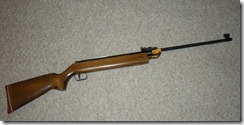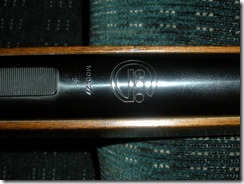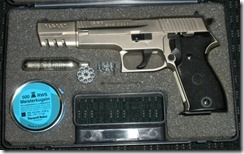Well, not new, just new to me.
My father used to shoot airguns a lot, especially when he was mostly into shooting muzzleloading rifles. Airguns allowed him to take a break from shooting a gun requiring cleaning after each time out at the range. Of late, he hasn’t been shooting the air guns, and a few years ago gave my brother his Weirauch HW-55 target rifle.
This afternoon I called over to my parents’ house and jokingly told my mom that I’d be over later to steal one of Dad’s air pistols. When I got there he brought down his 1970s-vintage Geco Diana Model 27 air rifle for me to take home. Apparently, the message got garbled.
Anyway, the Diana Model 27 is a classic German made break barrel, spring piston air rifle that was produced for decades, from 1910 up until the 1980s. Dad’s – now my – Model 27 has a stock that looks different from most of the pics I’ve found online, more squared off and the trigger guard has a different shape.
Unlike most of the break barrel spring piston rifles you see nowadays, the Diana Model 27 is not a “magnum.” Muzzle velocity for .177 examples like mine should be around 650 – 700 FPS. For target shooting out to 25 yards this is fine. Back when we were kids, sometimes Dad would take us to the range and we’d just bring air rifles. The club we belonged to allowed you to shoot at stuff other than paper targets, so we’d gather up spent shotshells at the trap range, place them on the target frame at 25 yards, and plink at them with our air rifles. The Model 27 has plenty of power and intrinsic accuracy for that, it’s the shooter that is the limitation.
The rifle is more than 35 years old and probably had not been fired in 10 years before today, so before shooting it I did some preventive maintenance. First, the rubber butt pad looked like it needed a bit of rejuvenation, so I wiped it down with Armor All.
More importantly, I put two drops of silicone airgun oil on the breech seal O-ring, and two drops down into the compression chamber. The gun has a leather seal but it seems to still be in decent shape. At some point it would probably be good to have it inspected and probably replaced, though.
I only had time to put 10 rounds through the rifle this afternoon. My first shot was out in the 7 ring because the trigger was much lighter than I expected. Except for one shot that I yanked out into 8 ring my remaining shots were nicely clustered in the 10 ring. This rifle is a shooter!
The other airgun I brought home today is an RWS C225 pistol that Dad bought in 1998. RWS brought out this model in 1997 but it lasted only a few years on the market.
As you can see, it came in plastic case with fitted foam, two “magazines,” a CO2 cylinder, a hex key, tin of pellets, and the instruction manual.
The C225 is well made mostly from metal. In the hand it feels very much like my SIG P225 9mm.
As I understand it, the SIG-styled C225 is mechanically more or less the same as the Walther CP88. Although these CO2-powered pellet pistols look like semiautos, they are actually revolvers. The magazines are cylinders, as seen in the picture below.
To load the cylinder into the gun, you pull the latch above the trigger down, which allows the “slide” and barrel to move forward. The CO2 cylinder is contained in the grip. To replace it you press the “magazine release” button behind the trigger and the right grip panel comes off.
Pistols like the C225 and CP88 aren’t intended for formal target shooting, but more as fun guns or sub-caliber trainers for their centerfire counterparts. That said, the C225 should work well for practicing pistol marksmanship. I didn’t get to shoot it today but will surely do so tomorrow.
Along with the two guns, Dad let me take a couple tins of RWS Meisterkuglen wadcutter pellets, a box of 5 CO2 cylinders, some Beeman felt cleaning pellets, a .177 target scoring aid, and a small bottle of silicone airgun oil from the old Air Rifle Headquarters.







No comments:
Post a Comment